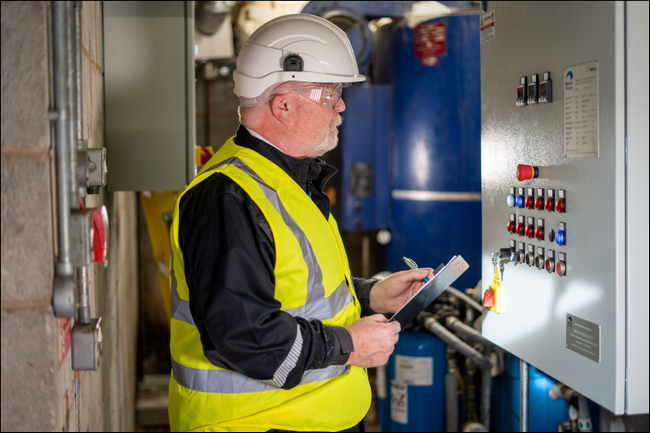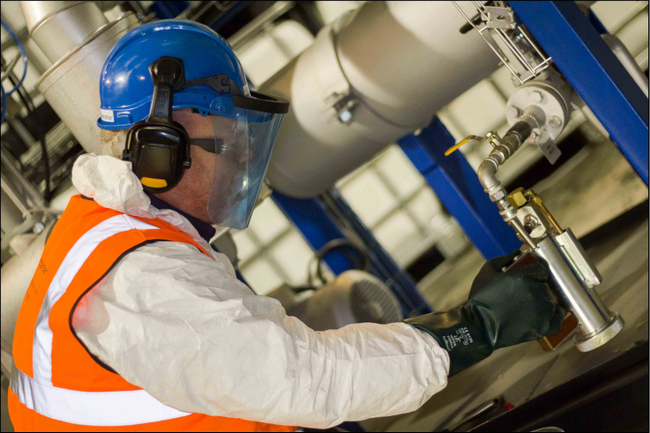Displaying items by tag: Global Heat Transfer
Indirect heat transfer maintenance
~ How choices around the facility impact heat transfer system performance ~
Our environment has a significant impact on how we work. According to a study by the Staples Corporation, 94 per cent of workers surveyed reported feeling more productive in a clean workspace. Businesses often want a clean space because it can reduce sick days, increase motivation and reduce stress, but did you know it can also improve equipment performance in manufacturing facilities? Here Dave Dyer, technical sales engineer at thermal fluid specialist Global Heat Transfer, explains how manufacturers can make changes around the facility to improve the productivity of their heat transfer system.
Proactive maintenance is vital when operating a heat transfer system. Regular maintenance of the equipment, as well as regular fluid sampling as part of a preventative maintenance programme such as Thermocare, enables manufacturers to monitor performance and fluid condition and prepare for maintenance before it leads to downtime.
While system and fluid maintenance are integral to productivity, manufacturers might still find that the system and thermal oil have a shorter lifespan than expected. In these situations, manufacturers might find that performance is impacted by conditions outside of the system.
So, how can the choices you make around the facility impact productivity?
Housekeeping
A clean, organised working environment can both aid productivity and keep workers safe, so facilities managers should consider how they can improve general housekeeping of heat transfer systems. Taking steps to clear pathways and remove electric cables and rubbish, for example, are quick ways to reduce trip hazards on site.
When working with dangerous and flammable substances, such as thermal fluid, manufacturers should pay close attention to any oil outside of the system. Any spillages should be cleaned up immediately — while a smaller spillage might not directly impact production, leaving it unattended can increase the risk of slips and trips as well as fires.

Equipment needs
Over time, parts of the heat transfer system will begin to wear, reducing overall efficiency. While manufacturers might concentrate on proactively maintaining core components of the system, they should also prepare for when that part breaks down. Unplanned downtime stops production and increases operational costs, so manufacturers should have spare parts on site to reduce any production losses. Keeping critical spares on site, such as pump cartridges, parts for the heater or burner and spare fluid for topping up the system, can be integral to maintaining production.
Signage
To remain compliant with health and safety regulations and pass safety audits, manufacturers must have clear signage across the facility about safety procedures. Labelling flammable and high voltage areas and other hazards is important when using heat transfer oils.
Facilities managers can also introduce signage across the facility to improve maintenance procedures. Correctly labelling fluid ensures that old and new fluids are not confused when topping up the system — adding old fluid into a new barrel will result in more waste. Manufacturers should also add signage to the system indicating the direction of oil flow.
In an emergency
We all know the saying “fail to prepare, prepare to fail”. Despite this, we often find that manufacturers have not adequately prepared for some emergency scenarios. While risk assessments may outline the probability of some of these issues occurring, facilities managers and health and safety managers should consider how they can better prepare for serious issues and ensure they are aware of who is best to call in each potential scenario.
Manufacturers should ask themselves what they would do if certain scenarios occur, such as the fluid going off low level, the heater stopping or the pump failing. Most importantly, manufacturers should consider how the facility would respond to major incidents. Having this plan in place is critical to protecting staff and reducing damage. Similarly, management teams must consider how to stop production quickly when issues occur. While many facilities have an emergency stop button, it is often located on or near the system. Placing the button far away from the system, in another room, by the door or by an exit, means that engineers can safely cease production while evacuating.
Storage
Where do you keep your thermal oil? To save on space, manufacturers can store oil outside, but leaving barrels to the elements can negatively impact the quality of the oil. For example, if rainwater sits on top of barrels or intermediate bulk containers (IBCs) and then the air temperature heats up, the barrel or IBC expands. Once it cools down, the container contracts, syphoning water from the top, rendering the new oil as unusable, even if completely capped and sealed.
Similarly, when replacing oil, manufacturers should take care to clearly label waste oil and new oil, keeping them separate in the facility. Mislabelling could cause problems further down the line, such as topping up a system with old waste oil.
Making improvements
Investing time and effort in preventative maintenance can improve site safety, increase productivity and reduce costs for manufacturers. Educating staff, both existing and new, on the importance of safety measures such as signage and housekeeping, as well as best practices like good oil storage and emergency planning, is integral part to heat transfer maintenance. Taking these steps is integral to regulatory compliance. For example, to comply with UKEX (formally known as ATEX 137) Regulations, manufacturers must follow best practice to ensure the safety of the site, monitor fluid to manage risk and train staff to effectively operate and maintain the system.
Just like a cluttered office can cause stress and reduce a team member’s ability to concentrate, a disorganised manufacturing facility can negatively impact machine performance. By including facility checks in proactive maintenance, facilities managers can extend the lifespan of their heat transfer system and better prepare for incidents that could lead to health and safety risks or costly downtime.
For more advice on heat transfer fluid and system management, contact thermal fluid supplier Global Heat Transfer by visiting www.globalhtf.com/contact.
About Global Heat Transfer: Global Heat Transfer is a thermal fluid specialist, providing heat transfer engineering assistance and thermal fluid supplies. Services offered include sampling and analysis, 24 hour delivery of premium quality thermal fluids, system drain down / cleaning / waste management, planned maintenance programs and a broad portfolio of affiliated system design and installation services. It is part of the Global Group of companies.
Thermal fluid or steam?
Many of us start our day by walking to the kettle to make a tea or coffee. If you don’t clean the kettle, after a while you’ll probably see a build-up of limescale. If this happens to your kettle, you can repair or replace it for a low cost — when working with heat transfer systems, these options are far from inexpensive. Here Clive Jones, managing director of thermal oil supplier Global Heat Transfer gives advice on choosing the right heat transfer system for your application.
Manufacturers traditionally use steam for indirect heat transfer in industrial processes. Steam based systems heat water to boiling point by igniting a flame into tubes that are submerged in water, producing steam. The steam then condenses back into water that can be collected and used again. This system is often preferred because water is easy and cheap to acquire and has no perceived environmental impact.
Alternatively, thermal fluid-based heat transfer systems operate using a burner that heats a coil containing the fluid. A pump then circulates the fluid through the system and around the plant.
What are the costs?
Steam-based systems require additional equipment such as a surge tank, water softener and blowdown heat recovery technology, to operate effectively. This is partly because, to operate at the high temperatures required for industrial processes, steam systems must operate at high pressures of about 85 bars or 8,500 kPa.

If the steam reaches a critical pressure and the system has no way to vent it, it can cause pipes to burst, leading to costly downtime. Using steam-based systems may also put staff at risk — hot steam escaping from burst pipes or shrapnel from the burst pipe has the potential to harm employees. Operators must therefore continually monitor the system to keep employees safe.
On the other hand, thermal fluid systems are simpler and cheaper because, unlike steam, they do not have to work at high pressure to maintain a constant temperature. Heat transfer fluids can operate at precise, high temperatures for extended periods of time and manufacturers can control the temperature depending on the application. These systems operate at atmospheric pressure and can easily be well vented, reducing pressure on pipes and improving safety for employees. While heat transfer systems may be the more efficient option, manufacturers should still carry out proactive maintenance. Monitoring thermal fluid condition with regular sampling and analysis enables manufacturers to identify and solve issues before they negatively impact production, preventing risks to safety and costly downtime.
Maintaining uptime and efficiency
Thermal fluids are more versatile, as manufacturers can select a fluid that is designed for a specific application, increasing its efficiency. There are a number of fluid options on the market, both synthetic and mineral, that have unique temperature ranges and recommended uses. For example, Global Heat Transfer supplies a range of high and low temperature heat transfer fluids, including Globaltherm® FG, a food-grade thermal fluid specifically manufactured for food and beverage processing, or Globaltherm® Syntec, a high temperature heat transfer fluid designed for use in the chemical industry. Manufacturers can work with a thermal fluid specialist to select a fluid that best meets the needs of their application.
Maintenance requirements
Water used in steam systems needs to be chemically treated to extend the lifespan of the system. However, corrosion is common, even in systems using distilled water, so operators must regularly monitor and maintain the system to reduce the risk of unexpected downtime.
Thermal fluids also require monitoring and maintenance because they degrade over time, particularly if running at high temperatures for long periods. For example, during the degradation process, thermal oils can be broken down into carbon molecules, which can stick to the pipes and reduce heat transfer efficiency. Regularly analysing fluids enables operators to monitor fluid condition and take any steps to slow down the degradation process, ensuring optimum efficiency.
Operators should also implement a proactive maintenance programme, such as Thermocare, which can include a remote monitoring solution that regularly monitors fluid. This sends instant alerts to site engineers when a sudden change occurs that may affect productivity, enabling companies to better manage their heat transfer fluid.
Overall, thermal fluid heating systems are safer, more efficient, cheaper to maintain and have better temperature control than using steam. Investing in thermal fluid heating systems prevents additional costs to maintain safety and efficiency, providing they are well maintained over time. So, you can sit back, relax, and pop the kettle on.
For more information on thermal fluid systems, and how to choose the right one visit: https://globalhtf.com/.
About Global Heat Transfer: Global Heat Transfer is a thermal fluid specialist, providing heat transfer engineering assistance and thermal fluid supplies. Services offered include sampling and analysis, 24 hour delivery of premium quality thermal fluids, system drain down / cleaning / waste management, planned maintenance programs and a broad portfolio of affiliated system design and installation services. It is part of the Global Group of companies.
